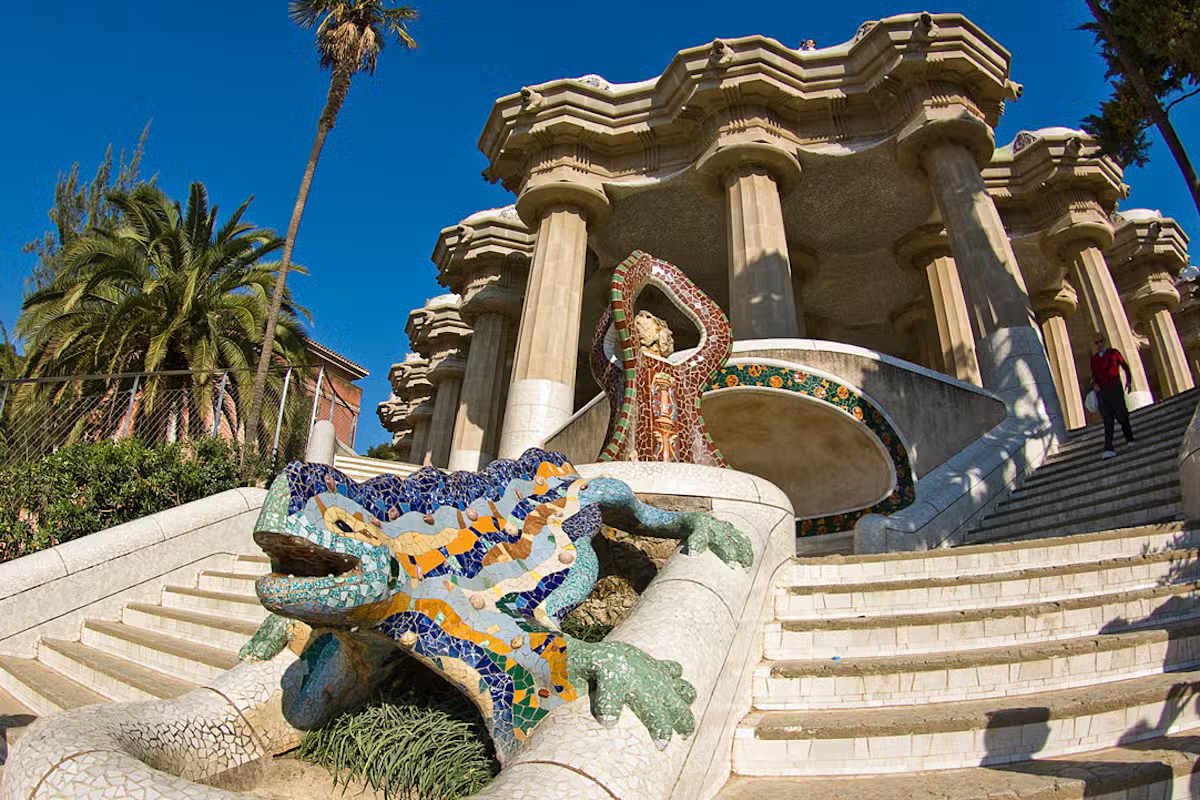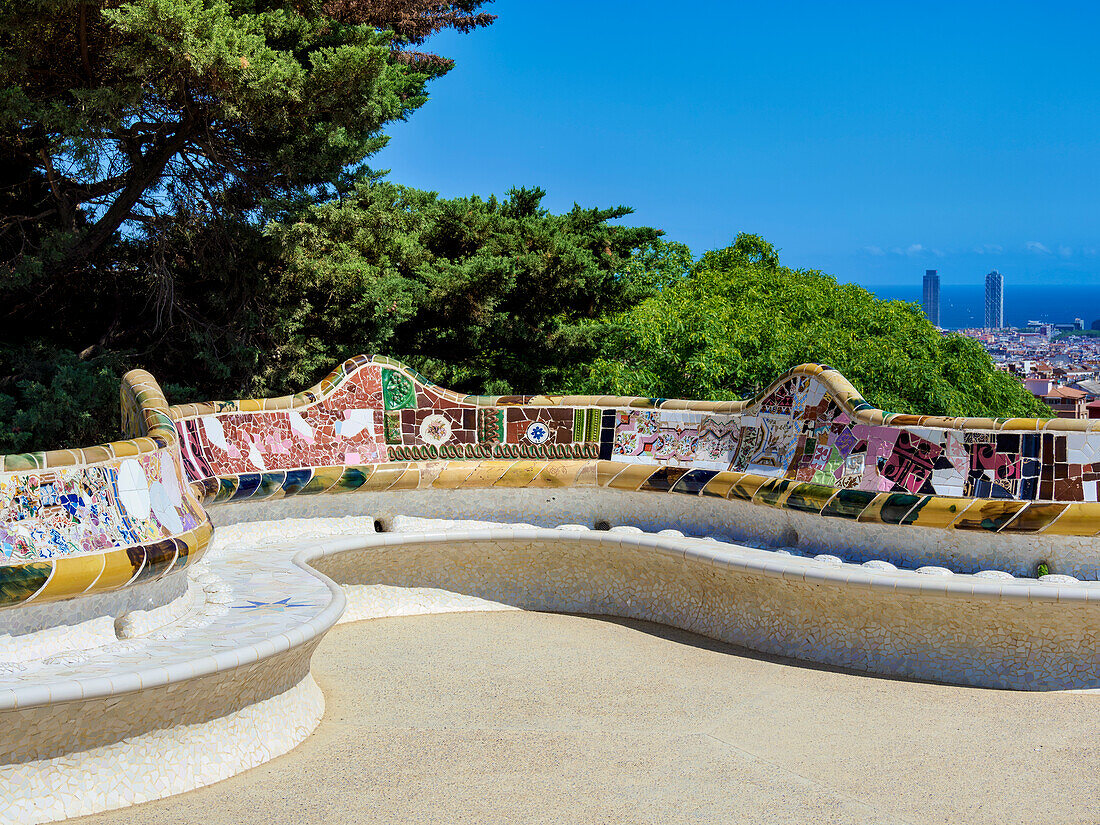Park Güell travel guide Barcelona: Nestled in the heart of Barcelona, Park Güell is more than just a park — it’s a living work of art created by Antoni Gaudí. Filled with colourful mosaics and flowing shapes, the park blends creativity and nature in perfect harmony.
Every corner reveals Gaudí’s playful imagination, making Park Güell one of Spain’s most photographed landmarks. Originally, it was designed as a residential garden city, but it later became a UNESCO World Heritage Site. Today, travellers from all over the world come to admire its beauty, colour, and charm.

The History of Park Güell: Park Güell travel guide Barcelona
Park Güell was commissioned by Eusebi Güell in the early 1900s and designed by Antoni Gaudí. It was first planned as a private housing estate for Barcelona’s elite. Gaudí, famous for his nature-inspired style, took a bold approach that mixed urban planning, art, and landscape design. The project didn’t succeed commercially, but in 1926 the area was transformed into a public park.
Today, Park Güell displays Gaudí’s signature blend of Catalan Modernism, neo-Gothic details, and organic architecture. Because of this, every pathway and mosaic feels alive, reflecting the connection between design and nature that defines his work.
What Makes Park Güell Special?: Park Güell travel guide Barcelona
Park Güell is an architectural playground filled with vibrant mosaics, curving paths, and colorful symbols of Catalan identity. As you explore, the park feels alive with creativity and joy. In addition, peaceful walking trails and wide viewpoints offer panoramic scenes of Barcelona.
Every corner reflects Antoni Gaudí’s playful imagination and his love for nature. Because of this, Park Güell becomes a perfect blend of art and landscape. It invites visitors to see the city from a fresh and inspiring perspective.

Top Highlights Inside Park Güell: Park Güell travel guide Barcelona
1. The Mosaic Dragon (El Drac)
The Mosaic Dragon—known as El Drac—is the most famous symbol of Park Güell. This colorful ceramic sculpture guards the main staircase and welcomes visitors to the monumental zone. Because of its unique design, it’s also one of the most photographed spots in Spain.
2. The Serpentine Bench
In the Placa de la Natura (Nature Square), you’ll find the Serpentine Bench, a long, mosaic-covered seat that curves gracefully around the terrace. From here, you can rest and enjoy panoramic views of Barcelona, including the Sagrada Família and the Mediterranean Sea on a clear day. Moreover, it’s a perfect place to relax and admire Gaudí’s creativity.
3. The Hypostyle Hall
The Hypostyle Hall, also called the Hall of a Hundred Columns (though it has 86), was originally designed to serve as a marketplace. Today, its Doric columns support the terrace above, while mosaic medallions on the ceiling showcase Gaudí’s love for nature-inspired patterns. As a result, the hall feels both grand and organic.
4. The Viaducts and Pathways
Throughout the park, you can walk along stone viaducts, winding paths, and shaded walkways that blend seamlessly into the landscape. In addition, these routes make it easy to explore every hidden corner of Park Güell while staying close to nature.
5. Gaudí House Museum (Optional)
For those who want to learn more about Gaudí, visit the Gaudí House Museum, which once served as his residence. Inside, you’ll discover personal items, sketches, and furniture that reveal his creative process. Though not included in the general park ticket, it’s worth a stop for anyone inspired by his work.

Tickets, Tips & Visitor Info: Park Güell travel guide Barcelona
🎟️ Monumental Zone
You’ll need a paid ticket to enter the Monumental Zone, which includes Gaudí’s famous mosaics and terraces. Tickets sell quickly, so it’s best to book in advance to secure your spot.
🌿 Free Area
The outer woodland and scenic walking paths are free to explore. Here, you can wander at your own pace, enjoy the shade, and capture beautiful panoramic views of Barcelona.
🕕 Best Time to Visit
Visit early in the morning or during the golden hour for soft light and fewer crowds. At these times, the park feels peaceful, and the colours appear even more vibrant.
💻 Online Booking
Reserve your ticket online to save time and choose your ideal time slot. Moreover, booking online helps you skip long lines at the entrance.
🚶 Accessibility
Some pathways are steep, but shuttle buses run from select access points. As a result, visitors of all ages can enjoy Gaudí’s hillside masterpiece without difficulty.
Tip: Book your ticket online via the official Park Güell website.
Photography Tips for Travellers: Park Güell travel guide Barcelona
Start your shoot early at the dragon statue to avoid crowds and capture the soft morning light. Next, use the curved bench as a leading line in wide-angle shots — it naturally draws the viewer’s eye through the frame.
After that, stay until sunset to capture the sky glowing over Barcelona’s skyline from the terrace viewpoint. Finally, explore creative angles along the stone colonnades and stairways to add depth and texture to your photos.
Why Park Güell Is a Must-Visit in Barcelona
Park Güell blends imagination, architecture, and nature, creating a space that feels alive and inspiring. Every path and mosaic wall shows Gaudí’s playful vision at its best. In fact, the park invites you to wander freely, discovering new colors and shapes at every turn.
Whether you’re an architecture fan, art lover, or casual explorer, there’s something unforgettable here for everyone. As a result, Gaudí’s fantasy garden stands out as one of Europe’s most magical destinations—a place where creativity and nature truly meet.
